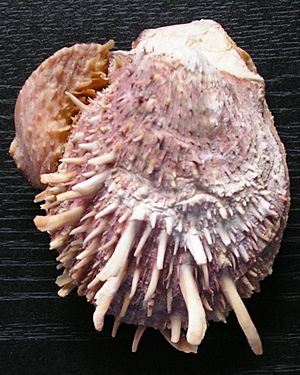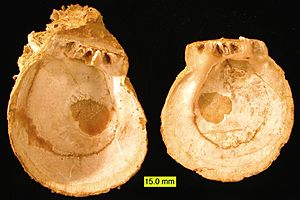Ostreoida facts for kids
Quick facts for kids Ostreoida |
|
|---|---|
 |
|
| Spondylus sp | |
| Scientific classification | |
| Kingdom: | |
| Phylum: | |
| Class: | |
| Subclass: |
Pteriomorphia
|
| Order: |
Ostreoida
|
The Ostreoida is a group of amazing bivalves, which are a type of mollusk. This group includes well-known creatures like oysters and many kinds of scallops. Bivalves are special because they have two shells that are hinged together, like a clam.
Contents
What are Ostreoida?
The Ostreoida order is a big family of sea animals. They are all bivalves, meaning they have two shells. These shells protect their soft bodies inside. Many Ostreoida species live attached to rocks or other hard surfaces in the ocean. Others can move around, like some scallops.
Scientists group animals together based on their shared features. The Ostreoida group includes many different types of bivalves. They are all part of the larger mollusk family, which also includes snails and octopuses.
Meet the Ostreoida Family
In 2010, scientists updated how they classify these animals. This helped us understand the Ostreoida family even better. Here are some of the main groups you'll find in the Ostreoida order:
Oysters
Oysters are probably the most famous members of the Ostreoida group. They are known for their rough, irregular shells. Oysters often live in coastal waters, attached to rocks or other oysters. They filter tiny bits of food from the water. Some oysters can even make pearls!
- Ostreoidea: This is the main group that includes true oysters.
- Gryphaeidae: These are sometimes called "devil's toenail" oysters because of their curved shape.
- Ostreidae: This family includes most of the oysters we eat.
Scallops and Their Relatives
Scallops are another very popular type of Ostreoida. They have beautiful, fan-shaped shells. Unlike oysters, many scallops can swim by rapidly opening and closing their shells. This creates a jet of water that pushes them forward.
- Pectinoida: This suborder includes scallops and their close relatives.
- Pectinoidea: This group contains the true scallops.
- Spondylidae: These are often called "spiny oysters" because their shells have many spines. They are related to scallops.
File Shells
File shells are also part of the Ostreoida family. They are known for their delicate, often colorful shells. Many file shells have a fringe of tentacles around the edge of their shell. They can sometimes "swim" short distances by clapping their shells.
- Limoida: This suborder includes the file shells.
Saltwater Mussels
While many mussels belong to a different group, some saltwater mussels are part of the Ostreoida order. These mussels typically have elongated, often dark-colored shells. They attach themselves to surfaces using strong threads called byssal threads.
- Mytiloida: This suborder includes certain types of saltwater mussels.
Winged Oysters
Winged oysters get their name from their shells, which often have wing-like extensions. They are sometimes called "tree oysters" because they can attach to mangrove roots.
- Pterioida: This suborder includes the winged oysters.
See also
 In Spanish: Ostreoides para niños
In Spanish: Ostreoides para niños


